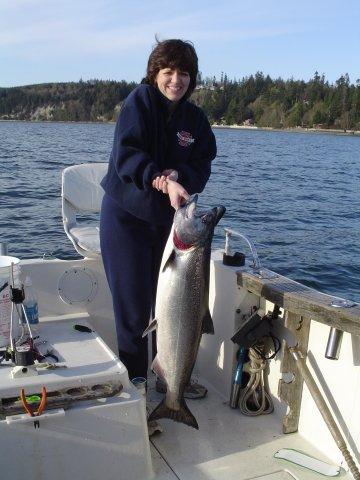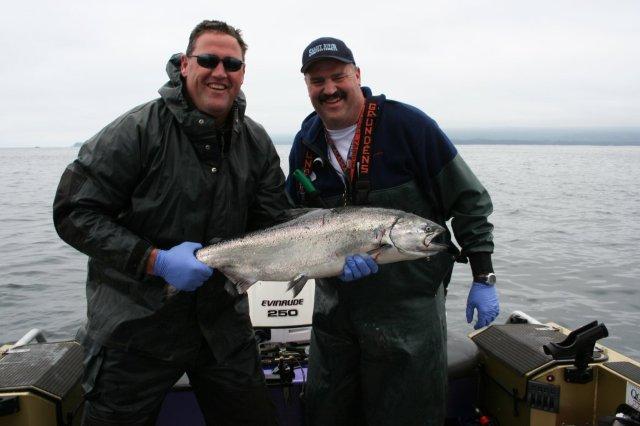Expiration Date: Leave a reply
To the winter-weary Northwesterner, the first of May signals the opening of many long awaited opportunities. Shrimp, lingcod and halibut seasons are all on tap and the warming inland waters offer the first genuine shot at bass, kokanee and trout as well.
While these traditional spring pursuits beckon, some of the best local action comes not at the beginning of the spring seasons but rather as the winter chinook or "blackmouth" season expires. In the waning days of our winter salmon season, the first returning Puget Sound adult chinook or "springers" arrive and close the season out with a chrome-plated bang!
Twenty-eight pounds of proof that Puget Sound springers not only exist, but are willing biters! Kathy Nelson is all smiles as she struggles to hoist her career-largest springer taken north of Everett, Washington.

While the Columbia River springers dominate the headlines and our efforts, Puget Sound springers, while not nearly as numerous, offer a shot at a local, jumbo chinook. While many anglers are making travel plans to take advantage of this Columbia River crop, a solid showing of springers silently sneaks into our local "S" rivers (Skagit, Stillaguamish, Snohomish, Skykomish and Snoqualmie).
Speaking in terms of time-of-entry, maturing chinook staging in the Sound prior to their spawning run is a fairly common occurrence. However, to consistently score on these “springer-mouth’s” you must target them by fishing where they are and by offering what they want.
These "S" river springers are most likely scattered and trolling with your Cannon downriggers will be the most effective technique. Instead of typical blackmouth or feeder chinook gear, i.e. flashers & spoons or squid, think along the lines of whole herring and Silver Horde plugs. My favorite way to fish whole herring is in a Krippled Herring “helmet” (www.krippled.ca) with the flasher rigged to the cannon ball. White Silver Horde plugs with a pink stripe down the side or white with a green back seem to be the best “plastic” producers. These maturing chinook will take flasher gear from time to time but you cannot beat bigger baits for these bigger fish.
Snohomish system kings are available on their first peek at the Snohomish estuary: Mission Bar. Although the area gets its name from Mission Beach, the bar extends from Mission Point to the Everett Harbor entrance and kings will be found all along its length.
Former University of Washington and Dallas Cowboy Lineman Kevin Gogan and 710 ESPN's Tom Nelson with a fine mid-April Mission Bar specimen that pulled the scale down to the mid-teens!

Slightly farther out in Possession Sound lays Hat (Gedney) Island and the south Hat bar that extends toward Pt Gardner Bay. Chinook rounding Possession Pt. and heading north will often bump in to the bar and stick around for a bite. Watch the tides and hit Hat on the flood.
In Bristol Bay, Alaska the commercial gillnetters will wait for the ebb tide to dry up the flats which will run the sockeye off the shallows and into their waiting nets. You can play the same game on Mission Bar, fishing it on the ebb to catch the fish backing off of the bar.
A bit farther to the north, Marine Area 7, otherwise known as the San Juan Islands offer a shot at not only spring chinook heading back to Washington waters but also early adults returning to Canadian rivers, most notably the Frasier. The only problem with the San Juan scenario is the number of unmarked hatchery fish as well as wild chinook that are hitting the "island buffet". If you don't mind a little catch and release while you look for a legal fin-clipped fish, you'll be in for a whale of a lot of fun!
The expiration date on this chinook opportunity in Marine Area 7, 8-1 & 8-2 is April 30, let’s get going and good luck!
Tom Nelson
The Outdoor Line
710 ESPN Seattle
www.theoutdoorline.com

